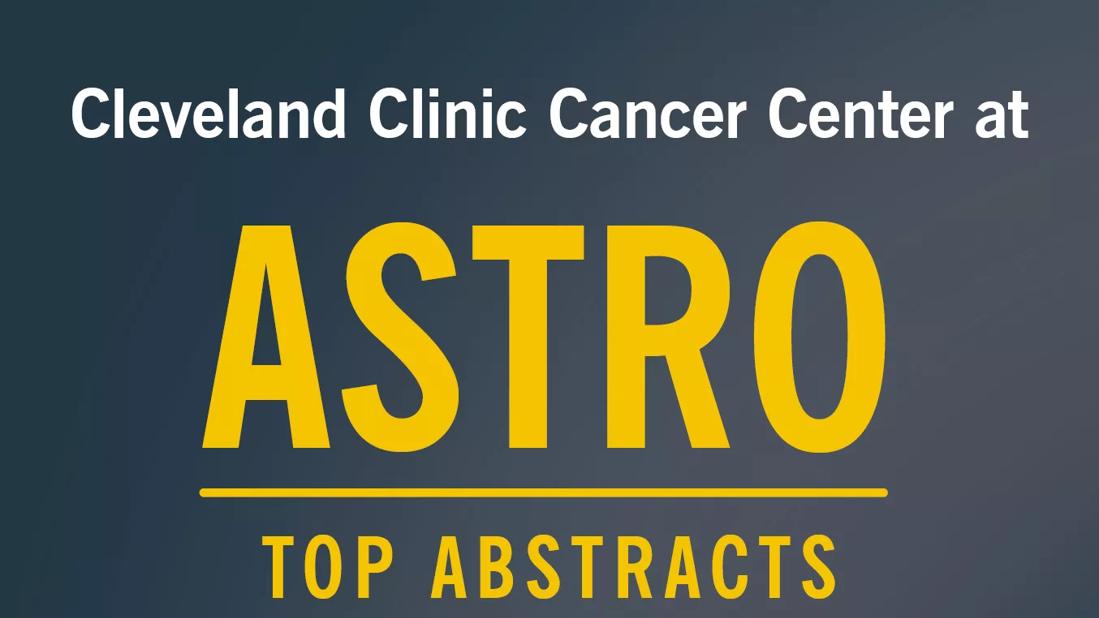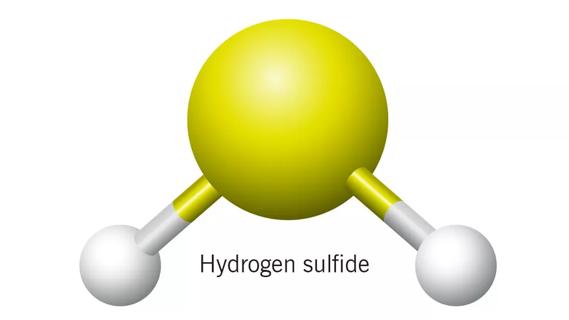Advertisement
Cleveland Clinic’s radiation oncologists select highlights

The American Society for Radiation Oncology’s (ASTRO) 2021 annual meeting featured the results of hundreds of important studies from the nation’s top cancer programs. The staff of Cleveland Clinic Cancer Center’s Department of Radiation Oncology has compiled the following list of ASTRO 2021 abstracts that our physicians consider to be the most intriguing, the most clinically relevant, or that have the greatest potential to change the practice of radiation oncology in the near future.
Advertisement
Cleveland Clinic is a non-profit academic medical center. Advertising on our site helps support our mission. We do not endorse non-Cleveland Clinic products or services. Policy
Phase III prospective randomized trial of 194 patients with HPV+ oropharyngeal SCC s/p transoral robotic surgery (TORS) and neck dissection randomized 2:1 to de-escalated adjuvant RT (DART) with 30 Gy/1.5 Gy/fx BID + docetaxel 15 mg/m2 days 1 and 8 (intermediate risk) or 36 Gy/1.8 Gy/fx BID + docetaxel 15 mg/m2 days 1 and 8 (high risk [ENE+]) versus SOC 60 Gy +/- weekly cisplatin 40 mg/m2. The primary end point was grade > 3 AE rate > 3 months after RT. Less toxicity, improved swallowing, and better QOL observed with DART compared to SOC. Among ENE-negative patients, DART also had excellent 2-year LRC (100%), PFS (97.6%), and OS (100%). However, for ENE-positive patients, DART had lower 2-year LRC (92%), PFS (78.9%), and OS (93.4%) compared to SOC. Patients with pN2 disease and ENE+ had the highest rate of failure with 2-yr PFS of 42.9% versus 100% for the same cohort treated with SOC. Conclusion: TORS+LND with DART is a reasonable choice for select early-stage HPV+ patients; however, a higher rate of failure is seen in pN2 patients with ENE treated with 36 Gy.
Phase III randomized controlled trial of 1538 patients with intermediate-risk prostate cancer with at least one of the following: clinical stage T2b-T2c, Gleason score 7, or PSA value >10 and <20 ng/mL (except for patients with all three of those plus 50% or more positive cores), with the outcomes of OS, biochemical failure, DM, death from prostate cancer. Patients were stratified by number of intermediate risk factors, RT boost modality, and comorbidities, and then randomized 1:1 to dose-escalated definitive radiation therapy (DART) vs DART + 6 months of TAS (TAS = LHRH agonist/antagonist plus oral antiandrogen). RT (no pelvic RT) was either EBRT alone to 79.2 Gy or EBRT 45 Gy + LDR or HDR brachytherapy boost. Most (67%) had only one intermediate risk factor. 88% treated with EBRT alone. Findings: 5-year OS was 90% DART alone vs 91% DART+TAS, not SS. 5-year biochemical failure was higher in DART alone arm (125 pts vs 68 pts, HR 0.52, p < 0.001). DM also higher in DART alone arm (28 pts vs 7 pts, HR 0.25, p < 0.001). More deaths due to prostate cancer in DART alone arm (10 pts vs 1 pt, HR 0.10, p = 0.007). More acute grade 3 or higher toxicities in DART+TAS arm, but no difference in late grade 3 or higher toxicities noticed in DART+TAS arm, but no difference in late grade 3 or higher toxicities. Conclusion: In men with intermediate-risk prostate cancer, the addition of 6 months of TAS to DART improves biochemical control, distant metastases, and death from prostate cancer but does not improve OS, with more acute toxicity from TAS.
Advertisement
Phase III randomized controlled trial of 296 patients with prostate cancer s/p prostatectomy who had an indication for adjuvant (undetectable postoperative PSA but pT3 or positive margin pT2, all pN0) or salvage (detectable PSA and pT2/3 pN0) prostate bed RT, with the outcomes of patient-reported GI and GU toxicity. Pts were stratified by EPIC score and ADT use (up to 6 months was allowed) and then randomized 1:1 to hypofractionated prostate bed RT 62.5 Gy in 25 fx (HYPORT) or conventionally fractionated prostate bed RT 66.6 Gy in 37 fx (COPORT). EPIC score was assessed at baseline, end of RT, and 6, 12, and 24 months after RT. No pelvic nodal RT. Findings: No difference in EPIC GU scores at any time point. GI scores were worse at the end of RT but resolved by 6, 12, 24 months. At median follow-up of 2.1 years, no difference in biochemical failure between HYPORT and COPORT groups was noted. Conclusion: HYPORT offers similar long-term GI and GU toxicity to COPORT for postoperative prostate RT.
Phase III prospective randomized trial of 735 women from South Korea with pathologically node-positive breast cancer after BCS or mastectomy with ALND randomized to breast or chest wall RT with regional nodal irradiation (RNI) +/- IM-nodal irradiation (IMNI). Neoadjuvant treatment was not allowed. The primary end point was DFS at 7 years. At median follow-up of 100.4 months, there was no difference in 7-year DFS for IMNI vs no IMNI, 85.3% vs 81.9% respectively. An ad hoc subgroup analysis demonstrated higher 7-year DFS with IMNI among patients with central/medial located tumors, 91.8% vs 81.6% (p= .008), with 7-yr breast cancer mortality rates of 10.2% vs 4.9% favoring IMNI (p= .04). There were no differences between the groups in AEs, including cardiac toxicity and radiation pneumonitis. Conclusion: IMNI with RNI did not significantly improve DFS in patients with node-positive breast cancer; however, patients with medial or central tumors may benefit from IMNI.
Phase II prospective randomized trial of 61 patients with T1-2N0-2 HPV+ oropharyngeal SCC randomized to de-escalated chemoradiotherapy (CRT) with 60 Gy and concurrent weekly cisplatin vs transoral robotic surgery (TORS) and neck dissection followed by risk-adapted, reduced-dose RT (50-60 Gy) based on pathologic findings. Primary end point was OS, secondary end points included PFS, QOL using MDADI, and toxicity. Trial closed early due to toxicity meeting pre-specified stopping rules in the TORS arm, including two treatment-related deaths (one hemorrhage, one cervical osteomyelitis). While survival outcomes remain immature at MFU of 17 months, RT and TORS demonstrated 2-year OS of 100% vs 89.1%, respectively; 2-year PFS of 100% vs 83.5%, respectively; and grade 2-5 toxicities in 67% and 71%, respectively. Mean MDADI total scores at 1 year were similar between arms. Conclusion: Primary TORS +/- RT was associated with an upfront risk of treatment-related mortality leading to suboptimal PFS, while de-escalated CRT demonstrated excellent oncologic outcomes with moderate toxicity.
Advertisement
Prospective randomized trial of palliative standard of care ± SBRT to all progressive sites. 102 patients with metastatic NSCLC or breast cancer who had received ≥ 1 line of systemic therapy with oligoprogressive lesions amenable to SBRT. Of the 106 patients enrolled in the study, 59 had non-small-cell lung cancer (NSCLC) and 47 had breast cancer. All participants in the trial had between one and five progressing metastatic sites that had not responded to systemic therapy; 75% had more than one oligoprogressive site. Half received SBRT to all progressive sites, and half were treated with the standard of care, which allowed physicians to choose whether to continue their current systemic therapy or switch to another drug. Patients were followed for a median of 45 weeks, by which time 78 (74%) patients had experienced further tumor progression and 39 (37%) had died. For patients with NSCLC treated with SBRT, the median progression-free survival was 44 weeks, compared to 9 weeks for those who received standard care (p=0.001). There was no significant difference in progression-free survival between the two groups of patients with breast cancer (18 weeks with SBRT vs 19 weeks with standard care, p=0.478). Conclusion: Consolidative SBRT improved PFS among patients with metastatic NSCLC, but not metastatic breast cancer.
Phase II/III prospective randomized trial of 109 patients at multiple sites in France with Stage I-III biopsy proven esophageal carcinoma randomized to FOLFOX-4 x6c + 40 Gy followed by 10 Gy vs. 26 Gy Boost. 80.1% IMRT. At 35 month median follow-up, OS was 25.2 months in the 50 Gy group vs 23.5 months in the 66 Gy group. There was no difference in local recurrence free survival at 2 years. Rates of G3-4 toxicities were similar. There were 5 toxic deaths in the 50 Gy group and 7 in the 66 Gy group, a nonsignificant difference. Conclusion: Dose-escalated radiation treatment with concurrent chemotherapy in stage I-III esophageal carcinoma did not improve OS. There was no difference in acute or late toxicity.
Advertisement
Prospective randomized trial of 355 pts with intermediate- (47%) and high-risk (53%) prostate cancer randomized to neoadjuvant and concurrent short-term ADT (goserelin x 4 months) and dose-escalated EBRT (76-82 Gy) or long-term ADT (goserelin x 28 months) and EBRT with pelvic RT being optional. After a median follow-up of 10 years, long-term ADT improved outcomes, including OS, compared to short-term ADT even with dose-escalated EBRT. The benefit was more evident in patients with high-risk prostate cancer (p=0.01). Conclusion: Long-term ADT improves OS compared to short-term ADT in the setting of dose-escalated EBRT.
Phase II single-institution study of 52 patients evaluating safety of 5 day neoadjuvant RT (30 Gy/5 fx) with standard margins for high-risk STS. Primary end point was grade ≥2 late-radiation toxicity. Initial MFU 29 months with 7 of 44 (16%) evaluable patients developing grade ≥2 late-RT toxicity (fibrosis, lymphedema, joint stiffness). Major wound complications occurred in 16 patients (32%) and were associated with lower extremity tumor location and also a germline biomarker. Update: An expansion cohort with pre-op RT (30 Gy/5) vs chemo RT (25 Gy/5) was opened in 2018. 52 patients with median 3 year follow-up were evaluated. Local recurrence was seen in 6.5% of patients, distant metastases in 20.8%, and all-cause mortality was 21.2%. Grade ≥2 toxicity was seen in 13% (fibrosis=5, stiffness=5, lymphedema=2). Major wound complications were noted in 26.7%. Conclusion: 5-day neoadjuvant RT demonstrates acceptable rates of wound complications and late toxicity with good local control.
Prospective pilot study of whether 18F-fluciclovine PET could distinguish radiation necrosis from tumor progression in brain metastases previously treated with SRS. The trial enrolled 16 patients with brain metastases, 15 of which were evaluable with 20 lesions previously treated with stereotactic radiosurgery. Patients were imaged with 18F-fluciclovine PET and followed clinically with 2 patients undergoing biopsy. Sixteen lesions were felt to be radiation necrosis, with the other 4 being tumor recurrence. 18F-fluciclovine PET was 100% sensitive in picking up tumor recurrence using a SUVmax cutpoint of 4.3. Specificity to rule out tumor progression was 0.63. SUVpeak and SUVmean were also predictive. When normalized, SUVpeak/normal remained predictive. Using a visual qualitative assessment score, two out of three physicians were able to distinguish tumor recurrence vs radiation necrosis despite lack of training. Conclusion:18F-fluciclovine is promising in diagnosing brain metastases recurrence versus radiation necrosis. Earlier diagnosis will allow for earlier treatment. Larger studies such as RELEVATE are currently open to further assess 18F-fluciclovine PET.
Advertisement
Advertisement

Large-scale joint study links elevated TMAO blood levels and chronic kidney disease risk over time

Investigators are developing a deep learning model to predict health outcomes in ICUs.

International collaboration is most genetically diverse study of the disease to date

Preclinical work promises large-scale data with minimal bias to inform development of clinical tests

Cleveland Clinic researchers pursue answers on basic science and clinical fronts

Study suggests sex-specific pathways show potential for sex-specific therapeutic approaches

Cleveland Clinic launches Quantum Innovation Catalyzer Program to help start-up companies access advanced research technology

Research project aims to pinpoint biomarkers that could speed diagnosis